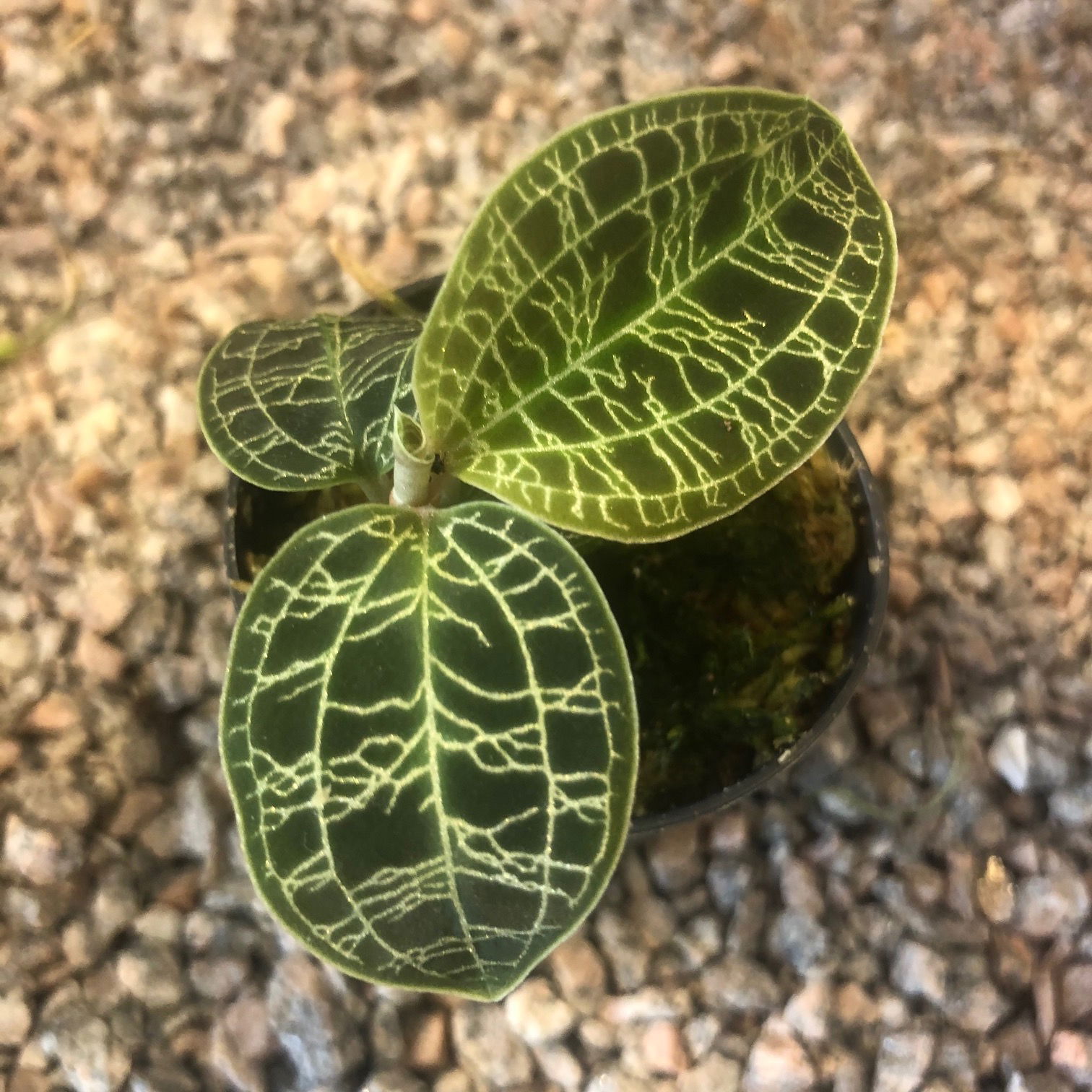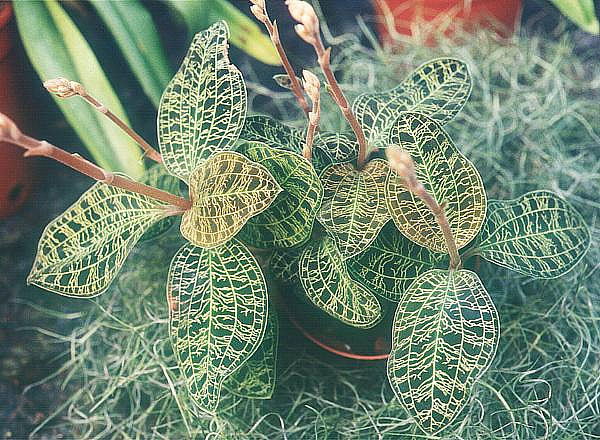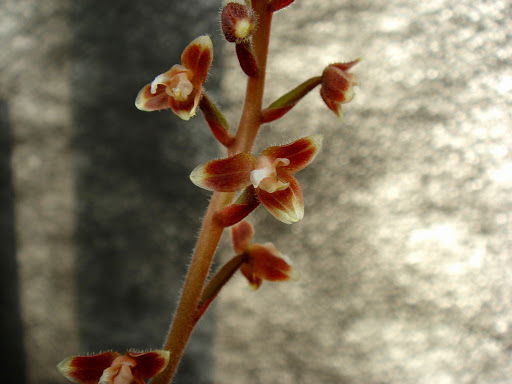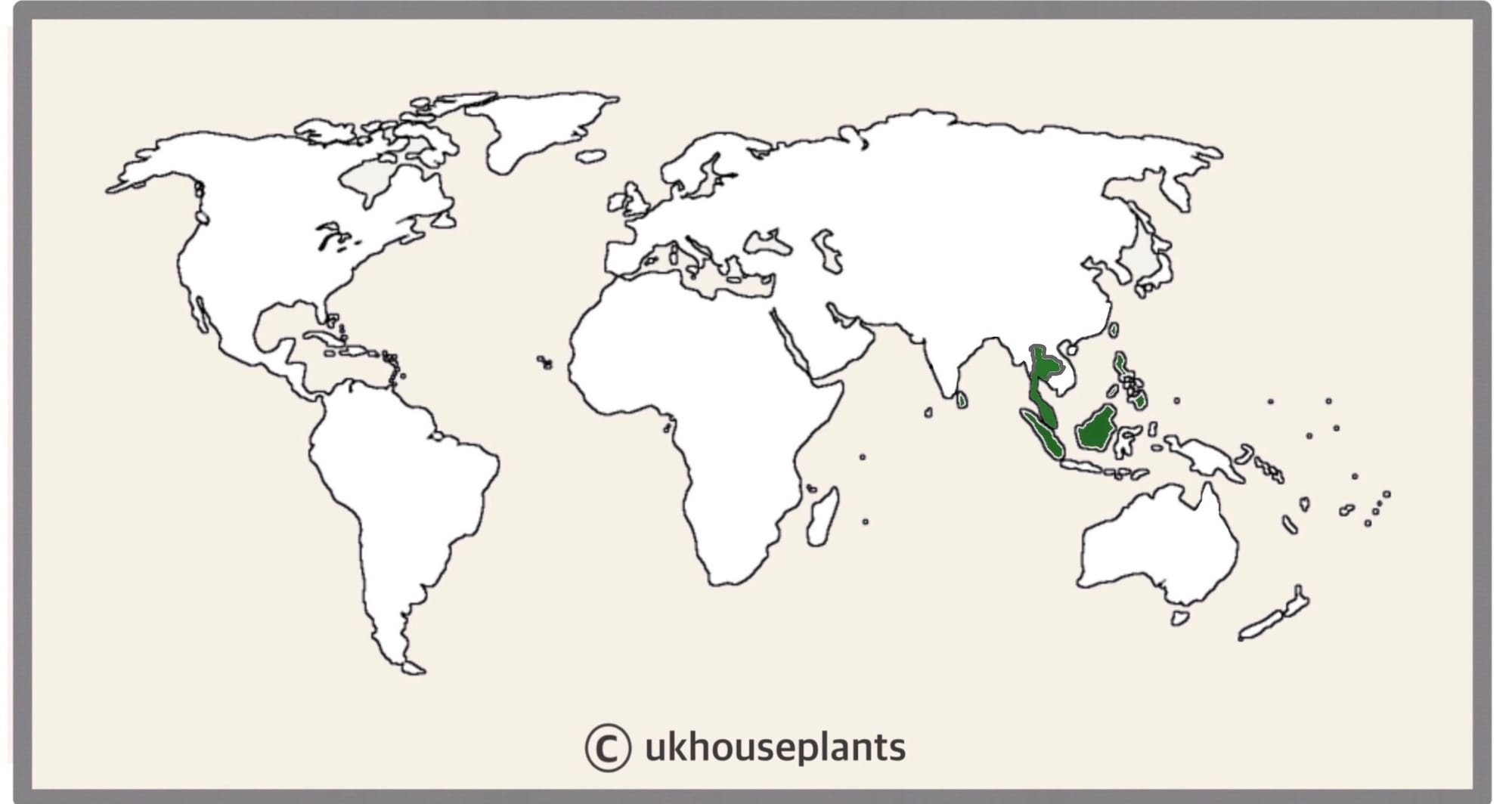
Macodes petola (Jewel Orchids)
Contents
- Top Tips
- Location, Water, Humidity & Fertilisation
- Dormancy Care & Annual Flowers
- Common Issues
- Origins, Temperature, Propagation, Repotting & Toxicity.
Need the answer to a specific plant query? Book a 1-to-1 video call with THE HOUSEPLANT DOCTOR™, the website's friendly author, to overcome and address your niggling problem! Available on iMessage, WhatsApp, Facebook Messenger & more.
Top Tips & Info
- Care Difficulty - Easy to Moderate
- Situate in a bright, indirect location that's away from the sun or operating heat sources. As Macodes petola grow terrestrially along the floor in the wild, they can be accepted as a shade-tolerant plant.
- Avoid persistent droughts and the use of cold water, especially while it's in bloom
- Keep the soil evenly moist, allowing the top third to dry out in between waters.
- Supplement with a houseplant-labelled fertiliser every two or four weeks depending on the season.
- 'Dormancy Care & Annual Bloom' will talk about acing its dormancy period for achieving flowers each winter.
- Repot every four years in spring, using a 'Houseplant' compost and the next sized pot.
- Keep an eye out for Mealybugs that'll infest the cubbyholes of the stem and leaves with white cottony webs.
- 'Tot' specimens in a 5cm pot are perfect for tropical-themed terrariums or displays due to the slow growth habits!
Location & Light - 🔸🔸
Macodes petola will accept all levels of indirect light, including semi-shady locations, north-facing windows and hallways. Of course, this Orchid will benefit from the natural light, but it's always good to know that it's tolerable to shadier situations.
In terms of the ideal room around the house, as long as the desired location is above 15ºC (59ºF) and is at least four metres away from an operating heat source, it should be fine. Never place it in direct sunlight as irreversible damage may occur, in the likes of yellow, mottled leaves from sun-scorch.
Water - 🔸🔸
Macodes petola require relatively moist conditions, with only the top third of the soil to dry out in between hydrations. If your specimen is grown in sphagnum moss, keep it mostly moist to avert the risk of dehydration. Under-watering symptoms include rapid flower loss, stunted growth and dry, sunken leaves; these issues are usually due to either forgetfulness, too much sunlight or too much heat. Over-watering symptoms include rotting lower leaves, yellowing leaves, a loss of buds or flowers and root rot. Allow the majority of the soil to dry out in between waters, preventing a pool of standing water from accumulating beneath the pot. Click here to learn more about identifying and addressing root rot.
Humidity - 🔸🔸🔸
Create a humidity tray to provide a moist and stable environment for your plant. If the surrounding saturation is too low or the heat too high, its leaf tips may start to brown over and curl, especially in direct sunlight. Mist the foliage down from time to time to hydrate the leaves and keep the dust levels down.
Fertilisation - 🔸🔸
During the spring and summer, while the plant is developing new foliage, use a houseplant-labelled fertiliser at monthly intervals. From late autumn to early spring, swap this for a product high in potassium, with tomato feed being a fantastic option. The potassium will stimulate flower stalks and prolong the flowering process, so it's important to keep the specimen well fed whilst in bloom.
 The delicacy of the Macodes petola's variegations is just truly stunning. Copyright: JoJan
The delicacy of the Macodes petola's variegations is just truly stunning. Copyright: JoJan
Dormancy Care & Annual Flowers
Macodes petola blooms are easily achieved when its dormancy irrigations are reduced by half; those who have a cooler room without artificial light at night will also be on the upper-hand. Keep the roots pot-bound to add further stress onto the specimen, which in turn will significantly heighten the chance of flowering. Blooms will generally appear in the winter but may occur later in the season.
The following steps should be done at the start of autumn until early spring when growth begins to slow. Always think of ukhouseplants' acronym of SHORT when it's time for flowers.
Sunlight & Location
Be sure to provide a bright location with little to no direct sunlight. Although the winter rays won't necessarily hurt the plant, be careful not to fall in the trap of sun-scorch and severe dehydration.
For it to fully become seasoned, avoid the use of artificial lighting or locations that boast temperatures higher than 18℃ (64℉) during the autumn and winter.
Hydration
Reduce waters so that about half of the soil becomes dry. It's essential to keep them on the drier side to life, as they'll think that hard times are ahead and therefore will need to pass its genes on to the next generation.
Occasional Feeds
Whilst coming into bloom from autumn onwards, use a Tomato feed to provide monthly nourishment of potassium.
Reduce Everything
This one is to remind you that everything needs to be reduced - especially the temperature.
Temperature
This is the most significant step - reduce the temperature down by around 5℃ compared to the summertime or place in a room that's around 15℃ (59℉). The drop in temperature should ideally last until the inflorescence finishes blooming, although it can still be transferred into the main house as long as it sits on a pebble tray. You'll be at a significant disadvantage if the ambient temperature is kept constant throughout the year, as Orchids will only respond with flowers in cooled environments. Never exceed the minimum temperature as it could lead to plant death or yellowed foliage at a bare minimum.
 The inflorescence of Macodes petola. Copyright: orchidspecies.com
The inflorescence of Macodes petola. Copyright: orchidspecies.com
Common Issues with Macodes petola
A lack of flowers is caused by an insufficient dormancy period, where the temperatures are kept more or less the same over the year. Reduce the temperature by a couple of degrees over the autumn and winter months, along with fewer irrigations to ensure a well-spent dormancy. The flowers will appear towards the tail-end of the resting period, whilst the temperatures are still on the lower side. While we're on the subject, if you'd like to prolong the flowering period, use a fertiliser high in potassium to promote longer-lasting flowers; Tomato Food is an excellent choice. Other tips to extend this period are to avoid severe temperature fluctuations and droughts, maintain good humidity and place in a well-lit room with little to no direct sunlight.
Yellowing leaves - it's difficult to accurately pinpoint why this is happening, as it could be due to many different reasons. If the lower leaves are yellowing in quick concession, over-watering may be to blame. Do not allow the soil to become soil or waterlogged as failure to do so will cause anaerobic (oxygen-lacking) conditions that aren't acceptable with Macodes petola. For severe cases, take the plant out of rot pot to examine for root rot - a transplant may have to be performed. Another reason could be due to either too much sunlight or not enough soil moisture. Under-watering can cause the specimen to slip into its dormancy period, but persistent droughts with direct sunlight will cause further damage in the likes of yellowing leaves, stunted growth and wilting.
Too low humidity can cause browning tips with yellow halos on juvenile leaves. Although this won't kill your specimen, you may want to increase the local moisture to prevent the new growth from adopting these symptoms. Mist or rinse the foliage from time to time and create a humidity tray while the heaters are active to create a stable environment. Browning leaf tips are an inevitable part of a leaf's maturity though, so never be too disheartened if your specimen is showing signs of this!
Mould or mushrooms developing on the soil means two things - too little light and over-watering. Despite the harmlessness, it'll prove unsightly to most gardeners and is therefore removed once known. To remove, replace the top two inches of the soil for a mixture of houseplant compost and orchid bark. Either increase the amount of light received (no direct sunlight for the first few weeks to prevent environmental shock) or decrease the frequency of waters slightly. If the mould is accompanied by yellowing lower leaves, you may also have a case of root rot.
Always use lukewarm water, and if you choose to use tap water, allow it to stand for at least 24hrs before application. Orchids tend to be quite sensitive to temperature change, so pouring cold tap water immediately into the pot will not only ionise your roots but could even cause yellow edges, sudden flower loss and stunted growth.
Never allow temperatures to dip below 10ºC (50ºF) as irreversible damage will occur in the likes of yellow foliage and weakened health. When this happens, remove the severely affected areas and immediately improve growing conditions - never cut through softened yellow growth, and only around brown, crispy squares. As rehabilitation can take several months because of its slow-growing nature, be sure to provide a stable location with better growing conditions to speed this process.
Pests could also be an issue, most notably being Mealybugs. Especially before purchasing, have a quick scan over the plant's foliage and flowers, inspecting its cubbyholes for the white critters. If yours has fallen foul of pests, click on the appropriate link to learn more about treatment, as well as observing what they look like.
Due to the species’ sensitivity to chemicals, Leaf Shine shouldn't be used to improve the appearance of the foliage, and instead should be cleaned via a rinse of lukewarm water. Failure to do so may cause yellowed, mottled spots that cannot be undone.
Curled leaves and brown leaf-edges are the result of too little water and over-exposure to the sun. Macodes petola are best located in bright, indirect settings, and those that haven't acclimatised to the harsh rays will show signs of sun-scorch and environmental shock. A splash of winter sunlight is acceptable as long as the soil moisture is regularly observed, with complete avoidance once summer comes along.
Short-lived flowers could be the product of low humidity. Place the specimen on a pebble tray, keeping the reservoir topped up with water while the heaters are operating. Never mist the flowers due to the high risk of developing Botrytis Petal Blight.
Origins
Similarly to the Ludisia discolor, this species originates from tropical Asia, growing largely as a rhizomatous Orchid in the ground. Macodes petola is now considered 'Vulnerable' according to CITES due to incompetent farming for traditional herbal medicine in Borneo. The species was initially penned as Neottia petola by Carl Ludwig Blume in 1825, before being reclassified in the newly constructed Macodes genus fifteen years later by John Lindley. The name, Macodes, originates from the ancient Greek word for 'length' which refers to the long lip on the flower's labellum.
 The Distribution of Macodes petola.
The Distribution of Macodes petola.
Temperature
12° - 25°C (54° - 78°F)
H1b (Hardiness Zone 12) - Can be grown outdoors during the summer in a sheltered location with temperatures above 13℃ (56℉), but is fine to remain indoors, too. If you decide to bring this plant outdoors, don't allow it to receive any direct sunlight as it may result in sun-scorch and dehydration. Regularly keep an eye out for pests, especially when re-introducing it back indoors.
Macodes petola will generally flower better in the winter months when the ambient temperature is dipped to around 16°C (60°F) during the autumn and winter.
Spread
Up to 0.2m in height and the width of its pot. The ultimate height will take between 4 - 6 years to achieve with around 3cm of lateral growth per season.
Pruning & Maintenance
Remove yellow or dying leaves, and plant debris to encourage better-growing conditions. While pruning, always use clean utensils or shears to reduce the chance of bacterial and fungal diseases. Never cut through yellowed tissue as this may cause further damage in the likes of diseases or bacterial infections. Remember to make clean incisions as too-damaged wounds may shock the plant, causing weakened growth and a decline in health. Remove spent flowers as they wilt and then the whole stalk once the show is over.
Propagation
Rhizomatous Stem Cuttings (Easy to Moderate) - During the spring, prune the tips of a few stems that have a slightly hardened base. Ideal cuttings should be at least 8cm (3 inches) in length and are found in the outer edge of the plant where the new growth takes place. Remove the older third of the leaves and submerge the rhizome loosely over a moist 'Houseplant' compost or live Sphagnum Moss. Place the cuttings (& its pot) in a transparent bag with small holes to lock-in a steady level of humidity for the first month of its new life. Keep the soil evenly moist and present a bright, indirect location away from the harsh rays. After the initial month, remove the bag and follow the care requirements documented at the top of the article.
 When taking rhizomatous cuttings, the specimen above is the minimum size for successful propagation; anything smaller may not root & therefore will be rendered fruitless.
When taking rhizomatous cuttings, the specimen above is the minimum size for successful propagation; anything smaller may not root & therefore will be rendered fruitless.
Flowers
Macodes petola will flower at the start of winter if grown correctly with a cooler environment during this time. Each individual flower will last up to twelve days, with the overall show lasting up to four weeks. Supplement the plant using a fertiliser high in potassium to prolong its flowers - Tomato feed is an excellent choice or even a Miracle-Gro product. Never promote persistent droughts as this will shorten the duration of flowers.
Repotting
Repot every four years in spring using a Houseplant' labelled compost or live Sphagnum Moss and the next sized pot with adequate drainage. Macodes petola are best suited for pots that are wide and shallow, as their rhizomes will spread laterally as suppose to downwards. The ideal depth of a container should be around 5 inches (from the soil line downwards).
Hydrate the plant 24hrs before tinkering with the roots to prevent the risk of transplant shock. For those that are situated in a darker location, add a thin layer of small grit in the pot's base to improve drainage and downplay over-watering. Click here for a detailed step-by-step guide on transplantation, or via this link to learn about repotting with root rot.
Pests & Diseases
Keep an eye out for spider mites, thrips, aphids & mealybugs. Common diseases with Macodes petola are root or rhizome rot, powdery mildew, leaf-spot disease, botrytis petal blight and powdery mildew - click here to learn more about these issues.
Toxicity
Macodes petola aren't considered poisonous when consumed by pets and humans; however, when high quantities are eaten, it may result in vomiting, nausea and a loss of appetite.
Retail Locations
Blue Diamond & Online Stores.
Book a 1-to-1 Call with THE HOUSEPLANT DOCTOR™
If you need further advice with your houseplants, book an advice call with ukhouseplants' friendly and expert writer today! This can be done via a video or audio call on most apps, including Facebook, FaceTime & Skype. A ten-minute call costs £5.99 (US$7), or £15.99 for thirty minutes. You can ask multiple questions, including queries on plants, pests, terrariums, repotting advice and anything in between. Please consider supporting this service to keep ukhouseplants thriving!